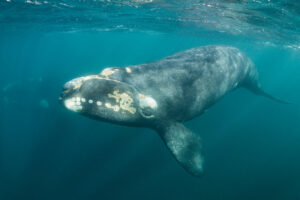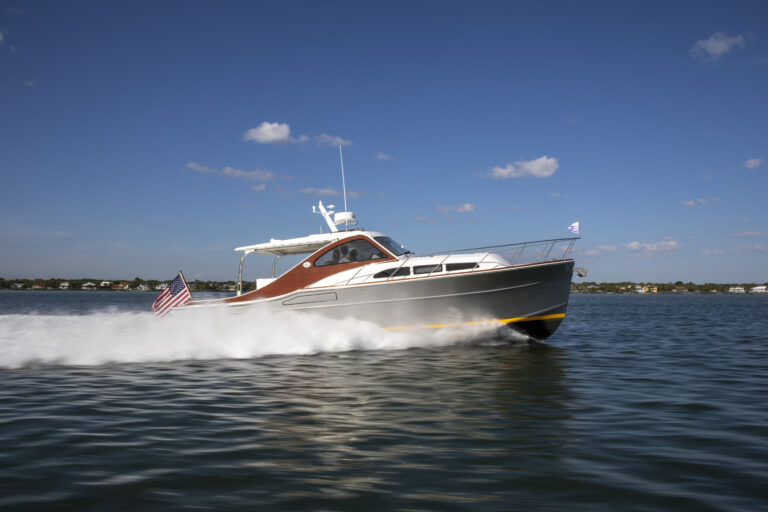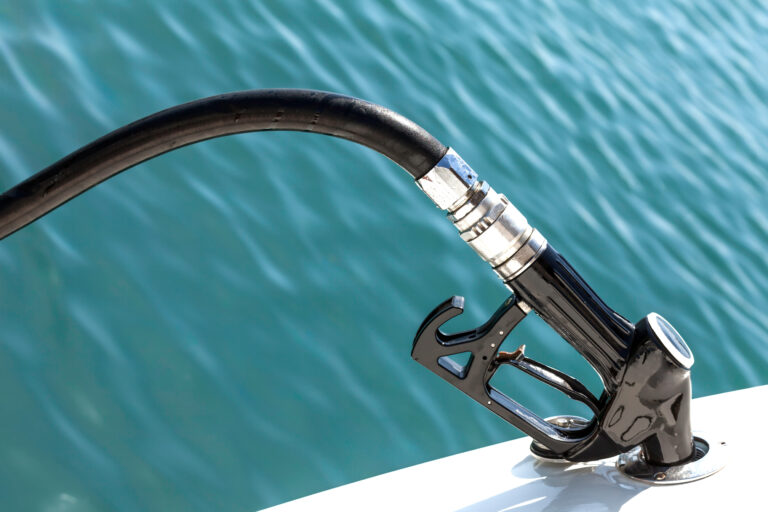Mercury’s chief program engineer Dan Balough talks about the company’s Hybrid Concept Vessel

Mercury Marine featured its Hybrid Concept Vessel at this year’s Miami International Boat Show – a 42-foot Maxum express cruiser equipped with diesel/electric power in a Zeus pod-drive configuration.
A 60-kW lithium-ion battery powers two 100-hp electric motors mounted between the 550-hp Cummins MerCruiser diesels. Under electric power, the boat can cruise up to 10 mph.
Under the joystick control of the Zeus system, you can glide along hearing only the sound of water hitting the hull. Electric power is also used with Zeus’ Skyhook function, which holds the boat in a designated position via GPS.
The boat is also equipped with solar panels under retractable sunpads on the foredeck and on the hardtop. They feed the battery under the cabin sole. The battery is charged in three ways – the diesels, solar panels or shore power.
The Hybrid Concept Vessel has turned out to be more than just a green in-house engineering project; Mercury has plans for a production model. To learn more about the boat, Soundings Trade Only caught up with Dan Balough, Mercury chief program engineer for hybrid and electrical systems, at the show.
Q: How long did it take to engineer the propulsion system and complete the installation in the concept boat?
A: A year and a half total – nine to 12 months of computer simulation, modeling and doing comparisons and fuel-economy studies … then another six to nine months of actually putting hardware together and completing the boat. There was a long period where it seemed like we weren’t getting anything done because it was all in the computer. But this made a lot of sense moving forward to make it into hardware. It started out as a proof-of-concept boat. It was strictly as an engineering piece, and we just liked the way it responded. We thought it would provide decent feedback at the [Miami] show, which is why we put some graphics on it and dressed it up. It really was intended to be an internal [project] in the beginning.

Q: So it was an experiment?
A: It was a concept boat, strictly meant to be internal. At some point we decided that it was good enough to make further refinements and go through with some cosmetics and then take it to the show. Hybrid propulsion is an up-and-coming trend. It’s pretty much a no-brainer when you look at automotive or industrial vehicles or buses. Many of them are hybrid. If they’re not hybrid now, there are plans to become hybrid. Years ago we recognized the trend and started to dabble and see if it was worthwhile for recreational marine.
Q: What are the long-term goals – will there be a production hybrid boat from Mercury?
A: There are a lot of things that have to fall into place for that to happen, but the feedback has been really good. So I think it’s just a matter of time before it happens. The intention to bring it to the show was to see which features were popular and useful. We packed the boat full of technology – solar panels, telematics system, warning lights, and of course hybrid – so there’s a lot of elements to it. We really wanted to show those elements off to see what is valuable and what is worth putting into a production piece.
Q: Can you estimate how long it will be until there is a production hybrid boat?

A: I’ve told people it feels like about two years away, but there are pieces of the boat that are closer to production than that. Solar pieces could be added to boats today without a lot of integration or development. They would just be an excellent use of the marine duty cycle. Just put them on the boat and keep your batteries charged up – makes a lot of sense to me.
Q: What size boat would Mercury use?
A: We’re not ready to say, but the boat we showed [a 42-footer] made sense for a demonstration purpose for two reasons. One, the Zeus system has a lot of very nice features, and when you execute them electrically it makes them even nicer. The electric Skyhook, I think, is just fabulous. And it was a big enough boat that you could take a lot of people on board and get a lot of feedback. With a smaller vessel you would have had smaller groups and less feedback, and you would have had to make more runs.
Q: Could this system be linked to non-Zeus propulsion?
A: Absolutely. A lot of our engineering work was done to make this hybrid architecture scalable – smaller boats or bigger boats. It is not locked into Zeus. It could go into sterndrives; it could go into inboards. And not just one type of sterndrive. It could go with Bravos and Alphas. It’s really attached to the engine side of the piece, so you would just make adjustments in the engine room and add [electric power].
Q: There was some skepticism at the Miami show about the solar power. What were the concerns voiced?

A: I think people … may have done some shopping for solar panels, or at least explored it, for their own homes. The solar power payback for your home is a lot different than what it would be for your boat because you’re usually living in your home and have systems alive 24/7 that need power. So you end up with a lot of compromises, depending on your house. I got the sense that people had enough background information about solar … and said, “Why would you do that? You’re adding weight to the boat with all that solar stuff on it.” But when they got off the boat they realized its value. The boat is sitting there days and weeks on end, doing nothing but sitting in the sun. You can use that to offset your electric bill and recharge your battery during downtime, and you don’t have to pay for electrical service. It’s just a good fit. I think people were convinced of that after they saw how it was being used and how the whole system was balanced and optimized. Do you have a bank of batteries in your basement or your garage? With a boat, because you have the battery storage, you can basically charge and use it when you need it.
Q: The solar panels are bifacial and absorb solar energy on both sides?
A: Correct. I thought it was a little bit of a risk because instead of looking at a clear piece of glass or a tinted piece of glass, you look up and you see these solar panels. But the initial feedback has been very positive. The panels sort of blend in with the hardtop, and people thought they were just skylights. The panels on the underside collect light from the reflections off the water.
Q: How many batteries are used with this hybrid system?
A: The number of batteries isn’t as important as the capacity, so think of it in terms of 60 kilowatt hours. There is a lot of talk about the Chevy Volt [concept car]. The Chevy Volt, I think, has a 15- or 16-kW battery, and it’s an electric car that can drive around for 40 to 80 miles on a single charge. This boat has, roughly speaking, four times that storage. It is significantly bigger than those in the automotive vehicles out there right now.
Q: Can you say which manufacturer you are working with?
A: No, and this goes for the power electronics and the electric motors – all those elements we’ve put together. They were modified to suit our needs, and we don’t really have any extended commercial agreements with those companies. We’re treating them basically like a supplier and not a development partner at this point.

Q: You mentioned electronics – are you using Mercury’s SmartCraft system?
A: The hybrid drive system works off SmartCraft. SmartCraft controls Zeus and the diesels, and it also controls the electric motors and the battery systems. There’s the motor and then there’s the battery, and the battery supplies energy to the motors. Between those two steps there’s an intermediate module called power electronics or motor controller. That’s another element of the overall system that we needed to integrate. If you look at the setup, the batteries go to a power electronics/motor controller piece and then you go to the motors, and the motors are linked to the drive train. These are new parts for a lot of people, including me.
Q: So the operator can choose diesel or electric power, and there’s a mode whereby the system handles that transition. How does that work?
A: It’s called Hybrid Mode. It is basically an automatic mode. It gives the computer the right to turn on and off the diesel, depending on where the throttles are and how much battery charge you have.
Q: How does the computer know when to switch to diesel?
A: It looks at how much throttle you are asking for – your demand on the throttles. If your throttle position is near where they would be for top speed, it would be running on diesel power.
Q: And is there an rpm setting where the diesel kicks in?
A: The concept boat is now calibrated to around 1,000 rpm. So 1,000 rpm and above it’s diesel, and below 1,000 rpm it’s electric. And 1,000 rpm on electric is roughly 10 mph.
Q: Could you calibrate to a higher rpm level?
A: In our boat it really wouldn’t make much sense because at that point the boat is pretty much mushing. The nose is up; it’s plowing a lot of water. It’s really a poor use of battery [power]. I guess technically it could go faster if you wanted, but it really makes no sense. Around 8 mph is good, between 8 and 10 it starts to get iffy, and above 10 it’s definitely not a good place to run the electric motors.
Q: How do you know the system is saving more energy than it is consuming during operation?
A: One of the big benefits is that we’ve removed the generator on our concept boat. The batteries supply all the power needed for air conditioning and lights, stereo, entertainment center, refrigerator, etc. If you spend a lot of time running near top speed, you’re probably not going to save much with our system, because the system is really designed to complement the low-speed operation. But if you think about it, there are a lot of no-wake zones and time spent waiting for bridge openings and other factors that require you to go at very low speeds. And now you can do it without any emissions and without burning any fuel.
This article originally appeared in the May 2010 issue.











